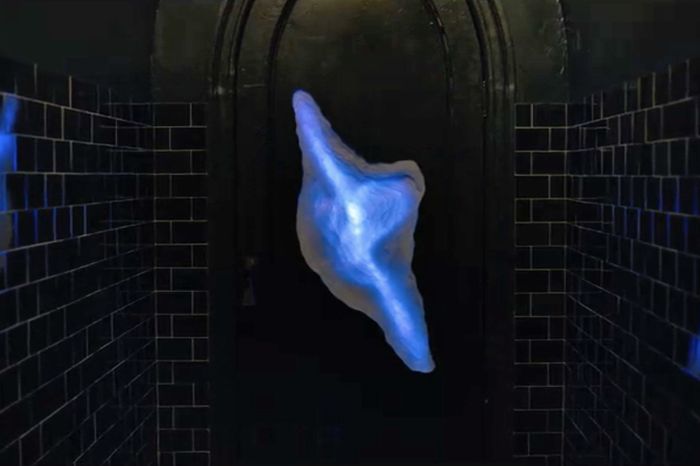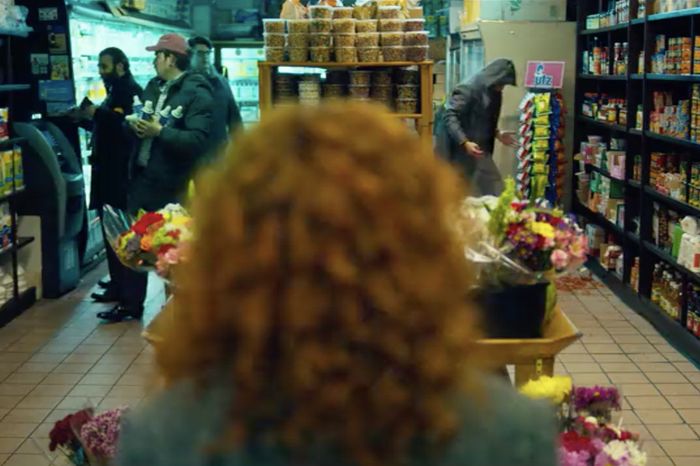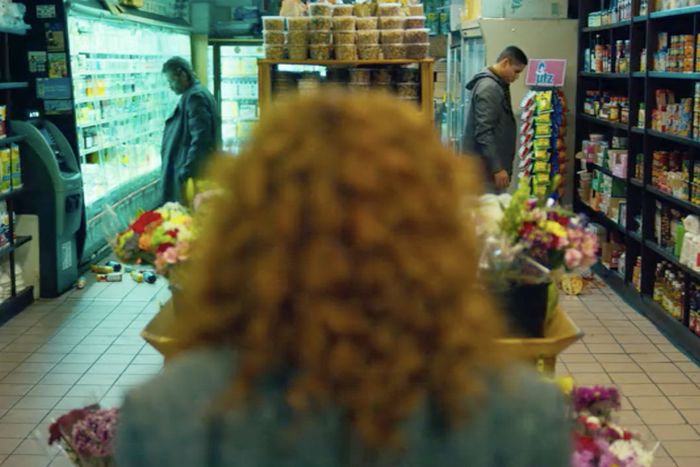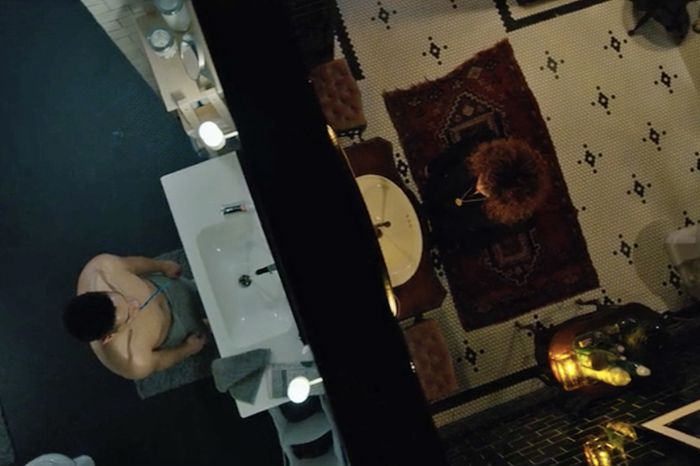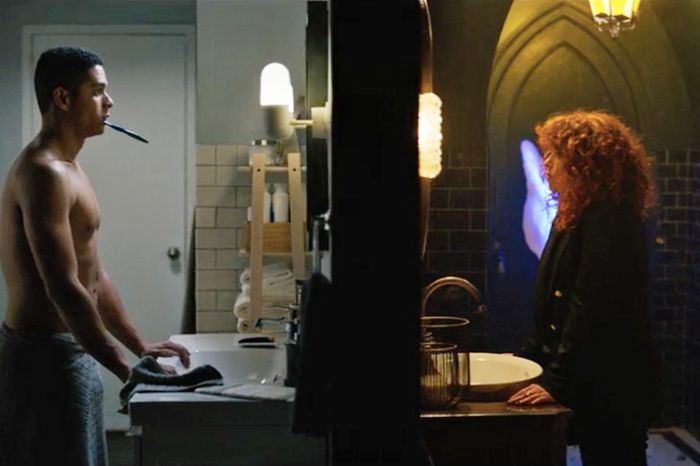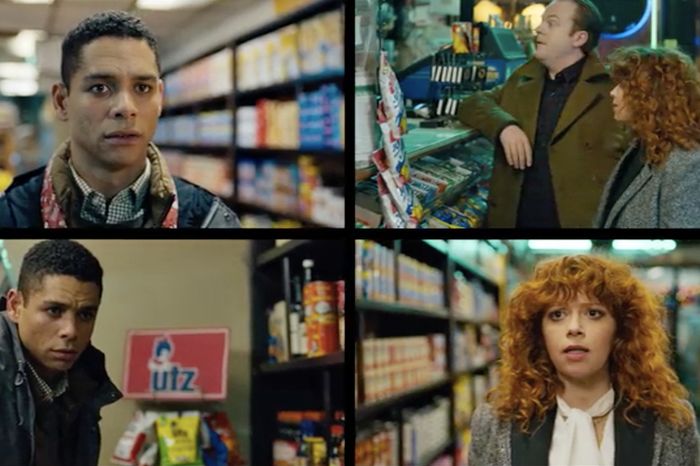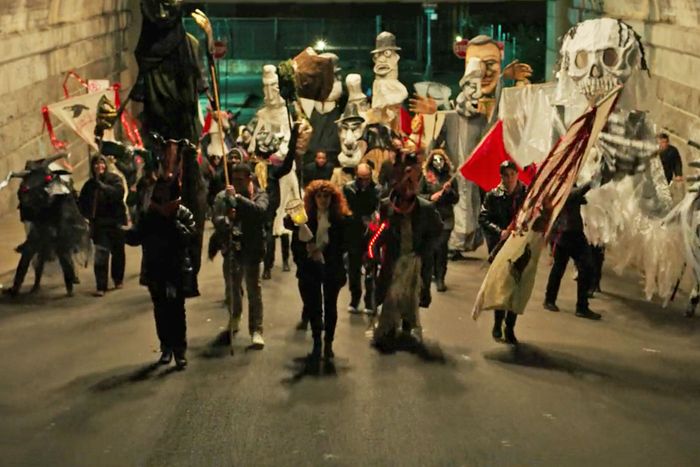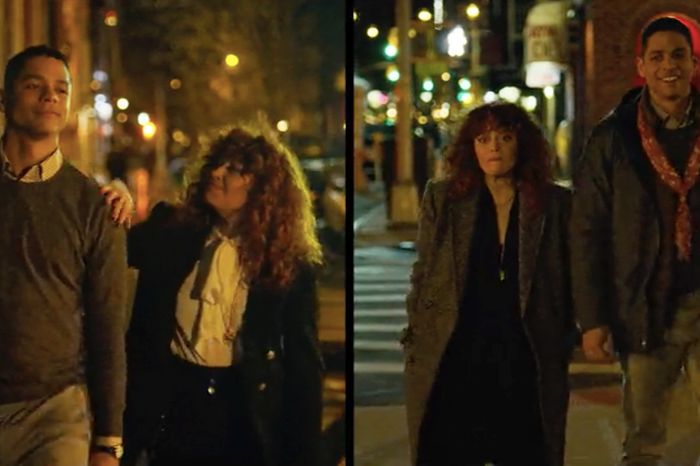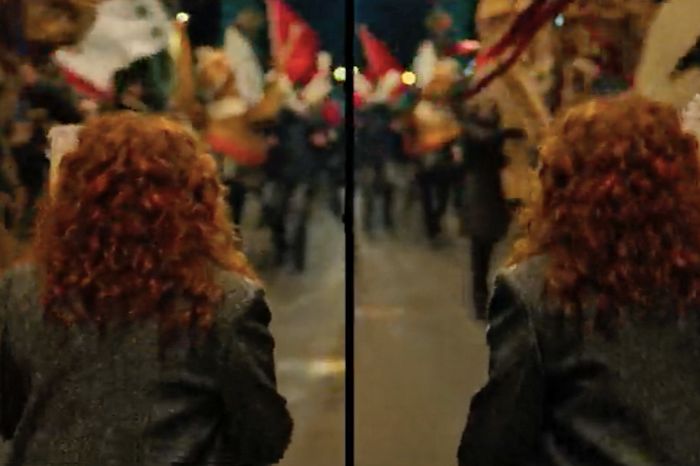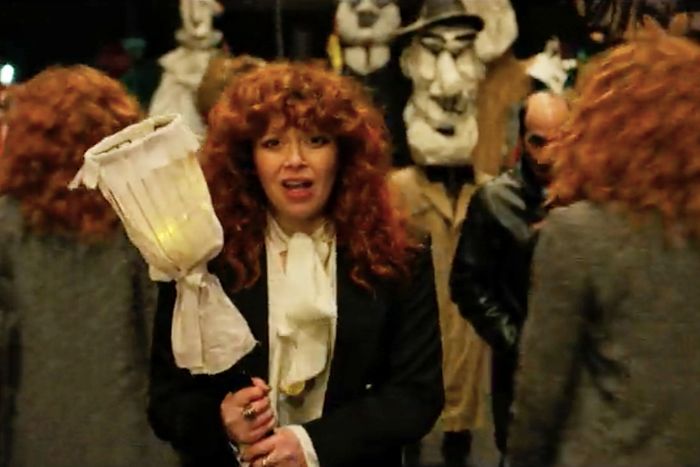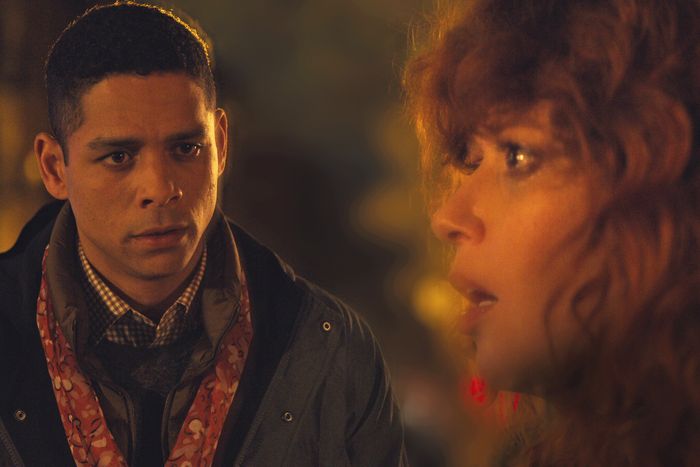
Nadia Vulvokov has come unstuck in time.
The heroine of Netflix’s Russian Doll — played by Orange Is the New Black’s Natasha Lyonne — seems to be trapped in a vicious time loop that keeps killing her mere hours after her 36th birthday. Death by fall, by car accident, by hypothermia, by gas-leak explosion, by elevator plunging to earth: Nadia doesn’t have a choice in how she goes. Nor does her eventual partner in dread, Alan Zaveri (Charlie Barnett) — a depressed, anal-retentive worrywart who’s stuck in a loop of his own, and meets Nadia on the aforementioned doomed elevator, calm as can be, because, like Nadia, he dies all the time. Their partnership is at the center of the first great TV series of 2019, co-created by Lyonne, Leslye Headland, and Amy Poehler, and so filled with surprises that you’ll want to watch the entire thing before reading anything about it. The exact chain of events leading Nadia and Alan to one demise or another becomes the subject of a metaphysical investigation. Their goal is twofold: (1) to figure out how to break the cycle and outlive the day, and (2) to discern whether these premature endings are the product of random machinations in the universe or individual choices that have karmically good or bad results.
This sounds at first like a big city, woman-centered version of Groundhog Day, Harold Ramis’s classic 1993 film starring Bill Murray as a TV meteorologist and unrepentant jerk who gets stuck in a time loop and escapes it only after embarking on a self-improvement regimen that transforms him into a wiser, kinder, more evolved person. Rather than avoid this comparison, Russian Doll leans into it. It even builds the deaths and reincarnations around a cheerful pop song that recurs every time the story resets (Sonny and Cher’s “I Got You, Babe” in Groundhog Day, Harry Nilsson’s “Gotta Get Up” in Russian Doll).
But Russian Doll belongs to a wider tradition of film and TV storytelling that’s about the relationship between personal autonomy and time itself — one that was perfected in Chris Marker’s 1962 short film La Jetée (remade as the Terry Gilliam feature 12 Monkeys) and that’s also reflected in dozens of books, movies, and shows made before and after. Notable work in this vein includes the Choose Your Own Adventure novels, Tom Tykwer’s movie Run, Lola, Run, Hiroshi Sakurazaka’s illustrated novel All You Need Is Kill (adapted to film as Edge of Tomorrow), and Duncan Jones’s movie Source Code. (For a more thorough list, see this Digg compilation by Matthew Olson, which starts in 1902 with a short story titled “Christmas Every Day.”) A more streamlined variant is the 1998 indie flick Sliding Doors, starring Gwyneth Paltrow as a woman whose life trajectory changes as a result of deciding to step on or off a commuter train at a certain moment; the consequences of that one choice are tracked in parallel timelines. Presumably every decision that the two main Russian Doll characters make could unfurl a la Sliding Doors — extended, linear — if not for the inconvenient fact that (until the very last episode) Nadia and Alan’s choices have no effect on their lifespan, other than to prolong them by a few hours and alter the cause of death.
What makes this series stand apart from its predecessors is the way it blends parable, psychodrama, and science fiction while maintaining plausible deniability, so that the story doesn’t fall too neatly or obviously into any of those three categories.
At times Russian Doll plays like a purely intellectual exercise in puzzle-solving, a left-brain exercise in bloodless intellectual mastery, like the Choose Your Own Adventure books, wherein young readers keep dying and then retracing their steps, to figure out how to make choices that will allow them to make it all the way through the story; or, more specifically, like the video games that Nadia, a coder, helps program at her day job. (Sure enough, we learn that Alan is a fan of the most successful video game Nadia worked on, and that her knowledge of programming helps her navigate the narrative architecture of the series.)
The recurring concern for Nadia’s beloved cat Oatmeal ties physics and philosophy together. Like The Sopranos — which presaged its cryptic, still-controversial, choose-your-own-meaning sign-off with a cameo by a feline (representing a character who had died violently) — you can read this as an allusion to Schrödinger’s cat, a thought experiment which states that “an object in a physical system can simultaneously exist in all possible configurations, but observing the system forces the system to collapse and forces the object into just one of those possible states.” Kind of like on a TV show, where you can really only follow one story at a time, no matter how quickly the storytellers cut from one plot to the next.
The title Russian Doll is one more source of puzzlement. It doesn’t relate to the story or the storytelling in any readily definable way (despite a scene where Nadia examines a Matryoshka doll) — except, somewhat glancingly, on the idea of mothers and children, Nadia being “abandoned” by her mother as a child, and “abandoning” the idea of having biological children of her own, as the result of that early trauma. (Oatmeal is the closest thing she has to a kid; in one scene, she even cradles him right over her belly.) As the episodes unreel, we aren’t seeing stories inside stories inside stories — except in relation to the decayed orange that Nadia cuts open, revealing a healthy, edible interior, perhaps symbolizing the nonfatal ending that she and Alan both seek — but something more akin to a gradual unveiling of narratives, each laid out like stretches of railroad track, all headed in the same direction. The tracks run next to one another, intersecting in spots that permit trains (that is, characters) to switch tracks.
But the lines almost always end prematurely and pitifully. And afterward, we return to the same core question: How to keep this game going longer, and longer, so that we survive the day and live to see another, and another, until — per one of Nadia’s monologues — we’re 60 and ready to wind down our time on Earth alongside a special someone whose job is to be there when we kick off?
Like the recent Bandersnatch episode of Black Mirror, Russian Doll tantalizes gamers with the possibility that life truly is “like a video game” — an experience that is, in the minds of some, a pure meritocracy, something you can win through creativity, dedication, and skill. If you think of life as a video game, you may believe that people somehow “deserve” to end up wherever they end up, by virtue of having made smart or stupid, right or wrong decisions along the way. In a video game, it’s possible to get a new life after “death,” retrace your steps, figure out where your trajectory took a wrong turn, and retroactively course correct (Edge of Tomorrow embraces the comparison explicitly, but many such tales have a touch of it — even ones that predate Pong). If life really is a game of some kind, it follows that resourceful individuals who aren’t content with factor presets could hack and reprogram it, skip through the difficult parts with cheat codes, and otherwise customize the experience.
This scenario is especially enticing to folks like Nadia and Alan, who are trapped in some sort of temporal/metaphysical cul-de-sac. As their purgatorial predicament stretches onward, they become obsessed not just with avoiding sudden death, but with uncovering and understanding the choices that led them to their respective unhappy places in life.
And it’s here that the show’s psychodramatic aspect snaps into focus.
The self-destructive, sarcastic, nihilistic Nadia — brilliantly portrayed by Lyonne, a quintessential New York wiseass who could be the love child of Barbra Streisand in What’s Up, Doc? and Mickey Rourke in Diner — is a reluctant participant in her own 36th birthday party. She’s haunted by the sudden, wrenching death of her mentally ill mother (Chloë Sevigny) at the same age, as well as by irrational but understandable feelings of guilt over failing to protect or save her. Nadia’s new pal Alan, meanwhile, is a self-punishing neurotic, stuck in a loveless relationship with a striving, dissatisfied girlfriend named Beatrice (Dascha Polanco, another OITNB regular). Beatrice is cheating on Alan with her college professor, a Jack Nicholson-esque blowhard Lothario named Mike (Jeremy Bobb) — the same Mike who becomes a Nadia conquest in one of her timelines. Like other characters who interact with both lead characters, Mike is proof that, literally as well as figuratively, We’re All Connected.
We learn much less about Alan’s past than we do about Nadia’s, but it’s implied that each character’s life could be represented by a branching timeline or flowchart, marked by a series of significant events or decision points, some obviously momentous — such as the death of Nadia’s mother, or Alan’s decision to propose or not propose to Beatrice — others seemingly fleeting, such as Nadia’s decision to reach out to a homeless man named Horse (Brendan Sexton III) who offers to cut her hair, and who, in one timeline, ends up freezing to death next to her in Tompkins Square Park. In every case, a choice is represented onscreen as a simple either/or, yes/no — a bit of real-life binary code, conceptually tying into Nadia’s job.
Notice, for instance, the framing of the bathroom door, as seen the first time, and as revisited throughout the series. Glowing vaginal artwork is affixed to the portal through which Nadia is born, or reborn, into her birthday party. And on either side of the psychedelic design, we see identical reflections on the room’s tiled walls: a mirrored composition. Two choices, one on either side of an element that divides the frame.
Now look at how the series frames Nadia the first time she’s presented with a choice of whether to interact with a drunk, suicidally depressed, hoodie-wearing patron whom she later recognizes to be Alan, or banter with a trio of drunk, condescending yuppies. It’s another composition with an element smack-dab in the center of the frame (Nadia’s head, as seen from the back), and a possible choice or course of action on either side, each “mirroring” the other. Another binary choice.
Russian Doll keeps returning to this “mirroring” shot, appropriately so, considering the importance of mirrors in the present-day story (both Alan and Nadia are introduced to us while staring into mirrors) and in Nadia’s childhood story (which climaxes with her unhinged mother destroying every mirror in their apartment).
True to Russian Doll’s preference for multivalent meanings, mirrors on the show never mean just one thing. The mirror used to represent the idea of a choice between two possible outcomes or narratives, as in a Choose Your Own Adventure book, a video game, or some other intellectual exercise where its possible to “solve” a story and attain finality. There are presumably an infinite number of alternated or “mirrored” universes existing side-by-side in Russian Doll, as in the hall of mirrors in a fun house, or one of those Star Trek episodes or comic-book stories in which the heroes glimpse an alternate reality where everything is the same yet fundamentally different.
At the same time, the mirror is also about self-regard and self-examination. There are moments when Russian Doll seems to suggest that our ability to really look at ourselves can mean the difference between a happy or unhappy life, or a long life versus a short one. It’s reminiscent of the Lady or the Tiger in Frank Stockton’s short story, or — to bring another cat, Schrödinger’s, into the mix — it’s the Lady and the Tiger. “On some occasions the tiger came out of one door,” Stockton writes, “and on some out of the other. The decisions of this tribunal were not only fair, they were positively determinate: the accused person was instantly punished if he found himself guilty, and, if innocent, he was rewarded on the spot, whether he liked it or not. There was no escape from the judgments of the king’s arena.”
But who is the “king” in Russian Doll’s universe? And what is the basis for his judgments, if indeed he (or she, or it) makes judgments? We don’t know. But we can still guess whether a lesson or moral is implied by the consequences of a character’s decision.
The parable aspect of Russian Doll becomes more important in the show’s last few episodes, especially in the finale. Nadia and Alan realize that the loop started when they ran into each other in a bodega — managed by another character, Farran (Ritesh Rajan), Alan’s close friend and Nadia’s acquaintance. They both failed to recognize each other’s humanity and intervene at what would later prove to be the moment when they were marked for death instead of life.
The final few minutes of Russian Doll seems to merge or reconcile Alan and Nadia’s timelines — a few of them, anyway — representing their physical progress through the world as split-screened, mirrorlike compositions which then become one. Maybe the problem, such as it was, has been solved, and all’s well that ends well. If so, the ending suggests that — to quote a conversation earlier in the series — neither time nor morality are truly relative; that it’s possible to change the course of one’s life, and another person’s, by doing the decent thing at what seems like a fleeting moment.
The tone of the last scene is raucous, upbeat, and reassuring. This is due partly to the music (Love’s “Alone Again Or”), but it owes just as much to the episode’s literary and visual structure. It starts with Alan and Nadia in different bathrooms, separated, as if on opposite sides of a literal and figurative mirror.
The episode builds toward one of its boldest images, a four-way split screen, as Alan and Nadia each reach out to the other in separate bodega timelines that overlap in the editing but not in their respective experiences (reflecting each other while remaining separate, like sides of a mirror).
The episode eventually ends with the “mirror” that is the split-screen dividing line being removed from our view, as Alan and Nadia enter the tunnel and head toward a parade that includes Horse, who is now wearing a horse’s head over his face. (Not coincidentally, a symbol of desire, travel, moment, and freedom from constraints.) That last shot does feel liberating. Maybe even happy.
“Love one another, because the universe is cruel and strange and inscrutable, and in the end, compassion is all we’ve got to hold onto” isn’t a terrible way to end a TV series with so many daunting layers. But it plays like a rather simplistic conclusion to a tale that had shied away from easy answers till then. If Russian Doll is, in some sense, science fiction, such a moral would nudge it closer to warm and conclusive works like Contact or Arrival than to films like 2001: A Space Odyssey or Annihilation, which are more open-ended and theoretical, and seem meant to elicit an idiosyncratic, Rorschach-like response.
But is the ending really that definitive, or that warm? On second viewing, I don’t think so. It raises a lot of questions.
Keep an eye on the clothing: The “final” versions of Nadia and Alan in the closing shot are both costumed with specific markers from their respective timelines where they had to save the “original” versions of each other, suggesting that their timelines rejoined one another — or possibly fused into a new timeline altogether.
It’s a little confusing because of an editing trick pulled right before the split screens disappear: At first, the Nadia on the left is wearing a black jacket with the white scarf (signifying she’s the “final” Nadia who saved Alan), and the Nadia on the right is wearing her traditional gray coat (signifying she’s the Nadia whom the “final” Alan saved from the cab). But after they turn toward the parade and the camera cuts back to them, both Nadias are suddenly wearing gray coats — the “final Nadia” has disappeared from the frame. She reappears moments later, facing the camera and holding a torch, while the pair of Nadias in gray coats walk past her, away from the camera.
So maybe what we’re seeing here isn’t a reconciliation of two timelines, but the intersection of three timelines, each with a Nadia of its own. They pass through each other, like ghosts traveling along separate trajectories while traversing the same haunted space. Perhaps this isn’t resolution, but the appearance of resolution, raising still more questions about what happened, what it meant, and how Russian Doll’s universe works.
If so, it’s a smart way to play things, at least if Lyonne, Headland, and Poehler intend to continue the series. The show’s writers now have an opportunity to build out this world, explore it in more depth, and dig into images, allusions, and situations that were dealt with fleetingly in season one — such as the healthy orange cores wrapped inside rotting skins; the relationship between individual decisions and the gradually thinning human, fish, and flower populations in the world; and the question of whether the survivors of repeatedly dying loop-prisoners (such as Nadia’s Aunt Ruth, played by Elizabeth Ashley) live on to grieve and remember the trauma of loss, or if their psychic slates reset with every death.
The challenge, of course, will be to maintain the show’s exquisite balance between science fiction, psychodrama, and parable—each mode coexisting and at times passing through the others like those intersecting timelines in the tunnel, yet never quite superseding one another, much less canceling each other out. That, and to refuse to kill the mystery and magic that makes Russian Doll so entrancing to watch, and so rewarding to revisit. To keep the story going, in other words: That’s the magic trick, the one we’re all struggling to learn, one day at a time.



